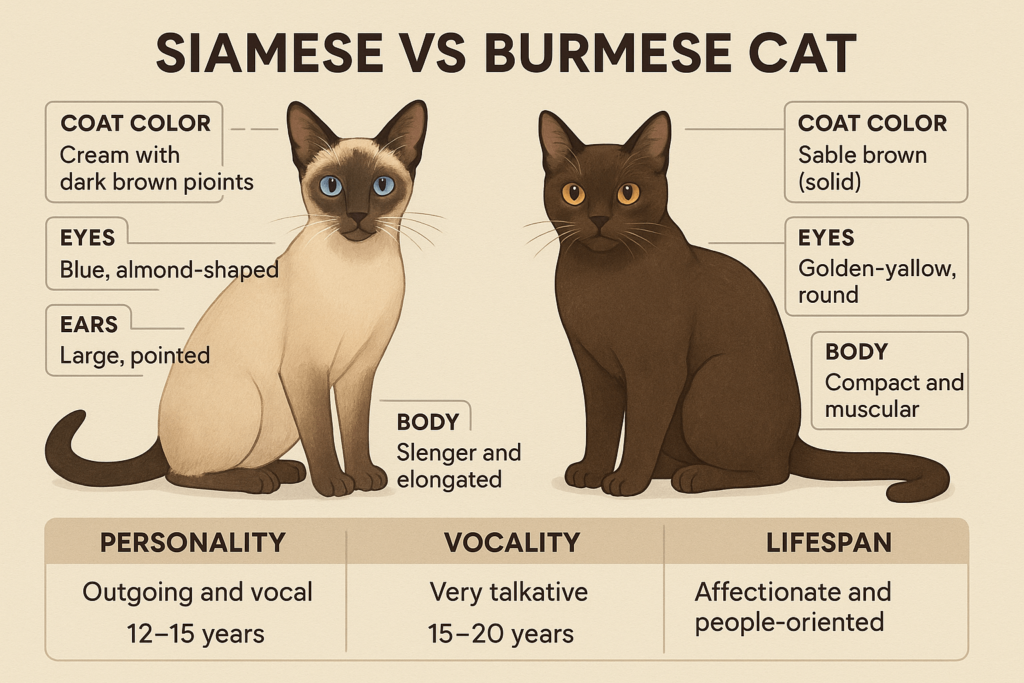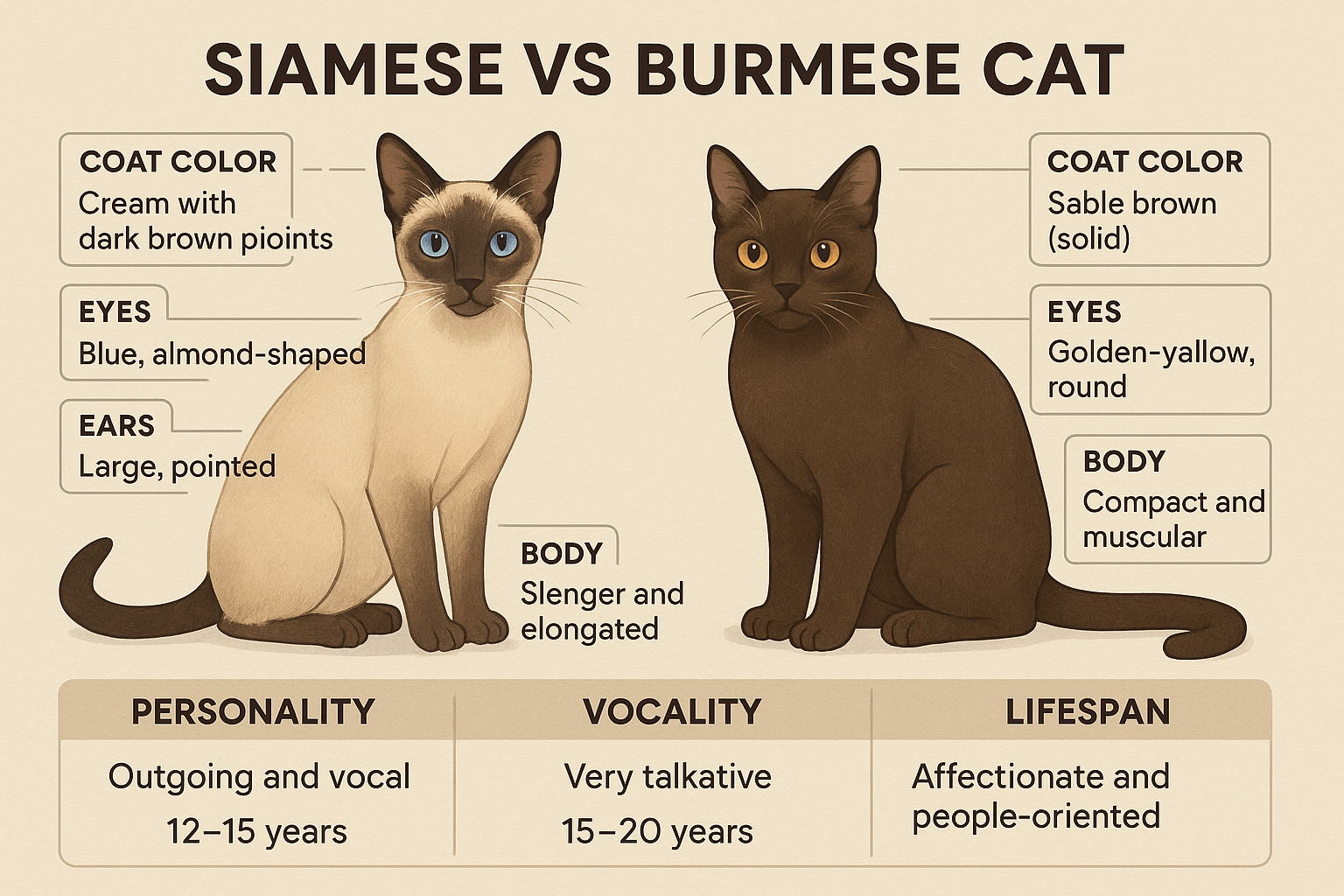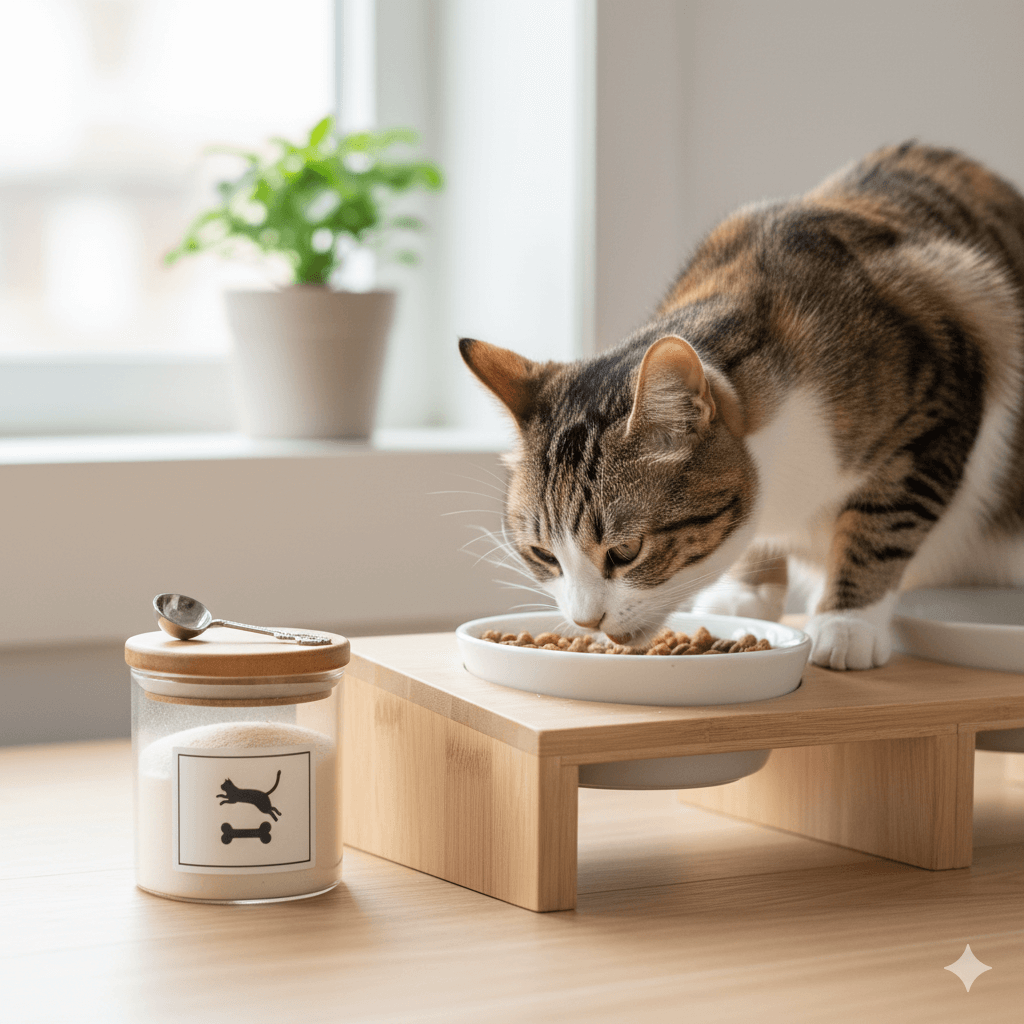Siamese vs Burmese Cat: Which Breed is Right for You?
Choosing a cat breed can feel like finding the perfect roommate—each one has its own personality, quirks, and charm. Two standout breeds, the Siamese and Burmese cats, are often compared due to their striking appearances and affectionate natures. While both breeds share some similarities, they also have distinct traits that set them apart. Whether you’re drawn to the chatty and elegant Siamese or the cuddly and sturdy Burmese, understanding their differences will help you make an informed decision. Let’s explore what makes these two breeds unique and discover which might be your ideal feline companion.
Physical Characteristics: Siamese vs Burmese
The Siamese and Burmese cats may look similar at first glance, but their physical traits reveal distinct differences that define their unique beauty. Here’s a closer look at their appearances.
Body Type:
Siamese cats are sleek and slender, with long, graceful bodies and fine bones. In contrast, Burmese cats are stocky and muscular, exuding a solid, compact build.Coat Colors and Patterns:
Siamese cats are known for their striking colorpoint patterns, featuring darker ears, faces, paws, and tails against lighter bodies. Burmese cats, on the other hand, sport a rich, glossy coat in solid colors like sable, champagne, or platinum.Eye Shape and Color:
Siamese cats boast almond-shaped, vivid blue eyes that captivate attention. Burmese cats have round, expressive eyes in golden or yellow hues that shimmer warmly.Facial Features:
Siamese cats have a distinctive wedge-shaped head with large, pointed ears. Burmese cats feature a rounded head and medium-sized ears, giving them a softer, more approachable appearance.Grooming Needs:
Both breeds have short coats that require minimal grooming, but Siamese cats tend to shed less due to their finer fur texture.
These physical differences highlight how each breed brings its own charm to the table, appealing to different aesthetic preferences.

Personality Traits: Siamese vs Burmese
While looks matter, personality plays a bigger role in determining whether a breed suits your lifestyle. Siamese and Burmese cats shine in this department, though their temperaments differ significantly.
Social Behavior:
Siamese cats are famously social and thrive on interaction. They’ll follow you around and demand attention, making them great companions for extroverted owners.Affection Levels:
Burmese cats are equally affectionate but in a quieter way. They enjoy snuggling and forming close bonds with their humans, often described as “lap cats.”Energy Levels:
Siamese cats are energetic and playful, often requiring plenty of toys and activities to keep them entertained. Burmese cats are more laid-back, balancing playtime with relaxation.Vocalization Tendencies:
Siamese cats are notorious chatterboxes, using their loud, raspy voices to communicate frequently. Burmese cats are softer-spoken, meowing gently to express themselves.Adaptability:
Both breeds adapt well to family life, but Burmese cats tend to be more patient with young children, while Siamese cats prefer households where they can be the center of attention.
Understanding these personality nuances ensures you choose a breed whose temperament aligns with your lifestyle and expectations.
Check this guide 👉Siamese Cat Lifespan: Best 7 Expert Tips!
Check this guide 👉Siamese Cat Personality: Best 7 Expert Tips!
Check this guide 👉Do Siamese Cats Shed? Best 7 Expert Tips!
Siamese Cat Traits | Burmese Cat Traits |
|---|---|
Sleek, slender body | Stocky, muscular build |
Colorpoint coat with blue eyes | Solid-colored coat with golden eyes |
Highly vocal and talkative | Quiet and soft-spoken |
Energetic and playful | Calm and affectionate |
Prefers constant attention | Enjoys independent cuddle time |
Health Considerations for Siamese and Burmese Cats
Both Siamese and Burmese cats are generally healthy breeds, but they do have specific health concerns that potential owners should be aware of. Knowing these risks allows you to provide the best care possible.
Common Health Issues in Siamese Cats:
Siamese cats are prone to dental problems, respiratory issues, and amyloidosis, a condition affecting the liver. Regular vet check-ups are crucial.Common Health Issues in Burmese Cats:
Burmese cats may face conditions like cranial deformities, diabetes, and heart disease. Early detection through routine screenings is essential.Lifespan Comparison:
Siamese cats typically live 12-20 years, while Burmese cats often reach 16-18 years with proper care.Dietary Needs:
Siamese cats benefit from high-protein diets to maintain their lean physique. Burmese cats require balanced nutrition to prevent obesity-related issues.Exercise Requirements:
Siamese cats need daily mental and physical stimulation to stay healthy, while Burmese cats remain active enough with moderate play sessions.
Being proactive about health management ensures both breeds live long, happy lives by your side.
Living Arrangements and Compatibility
Your living situation and household dynamics play a significant role in determining whether a Siamese or Burmese cat is the right fit. Consider these factors before making a decision.
Space Requirements:
Siamese cats enjoy vertical spaces like cat trees and shelves, while Burmese cats are content lounging on furniture or laps.Compatibility with Other Pets:
Siamese cats can coexist with other animals but may dominate interactions. Burmese cats are more adaptable and get along well with dogs and other cats.Suitability for Families:
Burmese cats are ideal for families with kids due to their gentle nature. Siamese cats fare better in homes where they receive undivided attention.Noise Sensitivity:
Siamese cats are less tolerant of loud environments, while Burmese cats handle noise and activity levels more calmly.Time Commitment:
Siamese cats demand more hands-on engagement, whereas Burmese cats are relatively low-maintenance yet still deeply affectionate.
Considering these factors helps ensure harmony between your chosen breed and your home environment.
Fun Facts About Siamese Cats
Siamese cats aren’t just beautiful—they’re full of fascinating quirks that make them stand out. Here are some fun facts about this iconic breed.
Historical Royalty:
Siamese cats were once considered sacred in Thailand (formerly Siam) and lived exclusively in royal palaces.Crossed Eyes Myth:
Early Siamese cats had crossed eyes due to a genetic trait linked to their eye shape, though modern breeding has largely eliminated this feature.Kinked Tails:
Traditional Siamese cats often had kinked tails, believed to signify good luck in ancient folklore.Movie Stars:
Siamese cats have appeared in numerous films, including Lady and the Tramp and That Darn Cat!Intelligent Problem Solvers:
Siamese cats are known for their intelligence, capable of learning tricks and opening doors with ease.
These intriguing tidbits add depth to the allure of Siamese cats, showcasing their rich history and captivating personality.
Fun Facts About Burmese Cats
Burmese cats are delightful bundles of charm and curiosity. Discover some lesser-known facts about this lovable breed.
Ancient Origins:
The Burmese cat descends from the copper-colored “Temple Cats” of Burma, revered as sacred protectors of temples.Dog-Like Loyalty:
Burmese cats are often described as having dog-like loyalty, following their owners around and eagerly greeting them at the door.Rare Breed Status:
Despite their popularity, certain Burmese coat colors (like lilac and chocolate) remain rare and highly sought after.Playful Into Old Age:
Unlike many breeds, Burmese cats retain their playful spirit even as seniors, staying youthful longer than most cats.Warm to the Touch:
Their short, silky coats give them a uniquely warm feel, making cuddles extra cozy.
These endearing qualities make Burmese cats irresistible to anyone seeking a devoted and charming companion.
Tips for Bonding with Your New Cat
Building a strong bond with your Siamese or Burmese cat takes effort, but the rewards are worth it. Follow these tips to foster trust and affection.
Spend Quality Time Together:
Dedicate daily time to interact with your cat, whether through play, grooming, or simply sitting together.Respect Their Space:
Allow your cat to retreat to quiet areas when they need downtime, respecting their boundaries.Use Positive Reinforcement:
Reward good behavior with treats, praise, or toys to encourage trust and cooperation.Talk to Them Often:
Engage in conversation—even if they don’t understand, hearing your voice strengthens your connection.Be Patient During Adjustments:
Give your new cat time to settle into their environment before expecting full bonding behaviors.
With consistency and care, you’ll create a lasting, loving relationship with your furry friend.
Frequently Asked Questions About Siamese and Burmese Cats
Are Siamese cats good for first-time owners?
Yes, but only if you’re prepared for their high energy and vocal tendencies.
Do Burmese cats require lots of grooming?
No, their short coats need minimal maintenance beyond occasional brushing.
Which breed is better for apartments?
Both breeds adapt well to apartment living, but Burmese cats are slightly more content in smaller spaces.
Can Siamese and Burmese cats get along?
Yes, they can coexist peacefully if introduced properly and given individual attention.
How do I train a Siamese cat not to vocalize too much?
Redirect their attention with toys or treats when they start excessive meowing to encourage quieter behavior.
Finding Your Perfect Feline Companion
Whether you’re enchanted by the elegance of the Siamese or the warmth of the Burmese, both breeds offer incredible companionship and joy. By understanding their physical traits, personalities, health needs, and compatibility with your lifestyle, you can confidently choose the breed that best fits your home and heart. Remember, adopting any pet is a lifelong commitment, so take your time to make the right decision. With love, patience, and care, either of these remarkable cats will bring endless happiness into your life.
Understanding Bone Supplement for Cats: Best 7 Expert Tips! – Safe, vet-approved guidance for strong feline bones & balanced nutrition.
Bone Supplement for Dogs: Best 7 Expert Tips! – Expert guide to calcium, collagen & bone health for every life stage.
Understanding Can Cats Get Sunburn: Best 7 Expert Tips! – Protect your feline from UV damage with vet-backed prevention strategies.
How to Train a Seizure Alert Dog: Best 7 Expert Tips! – Learn expert-backed steps to nurture natural instincts into reliable, life-saving seizure alerts.





